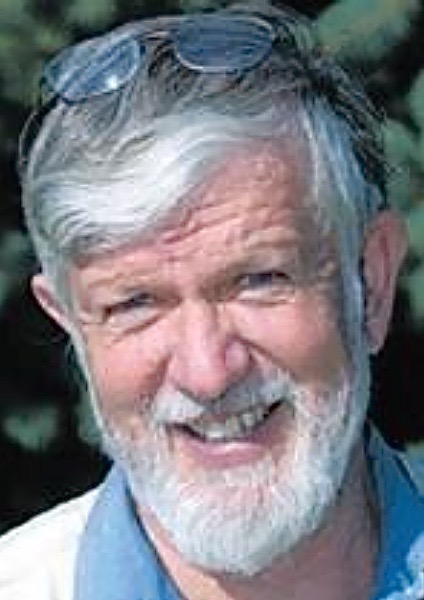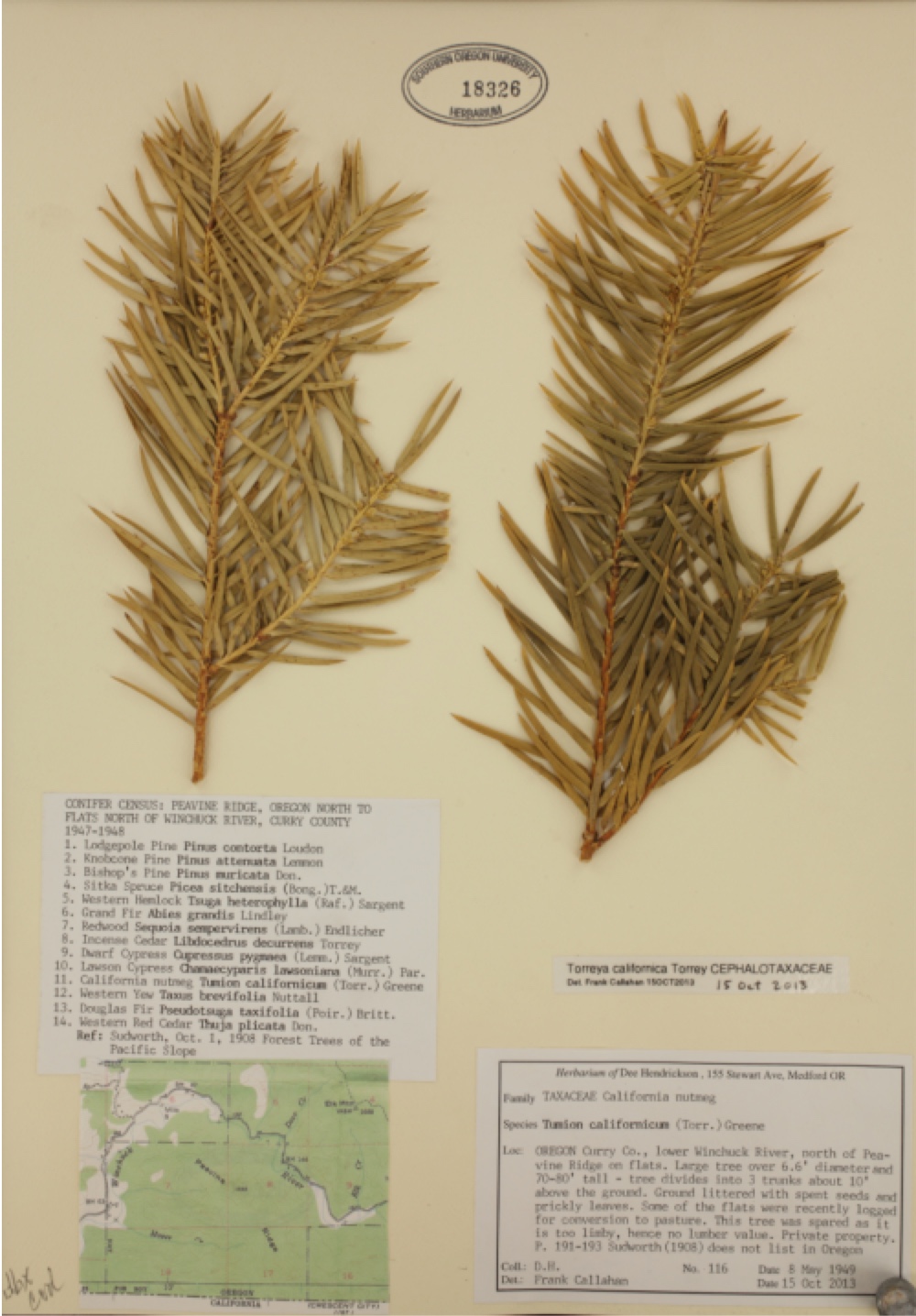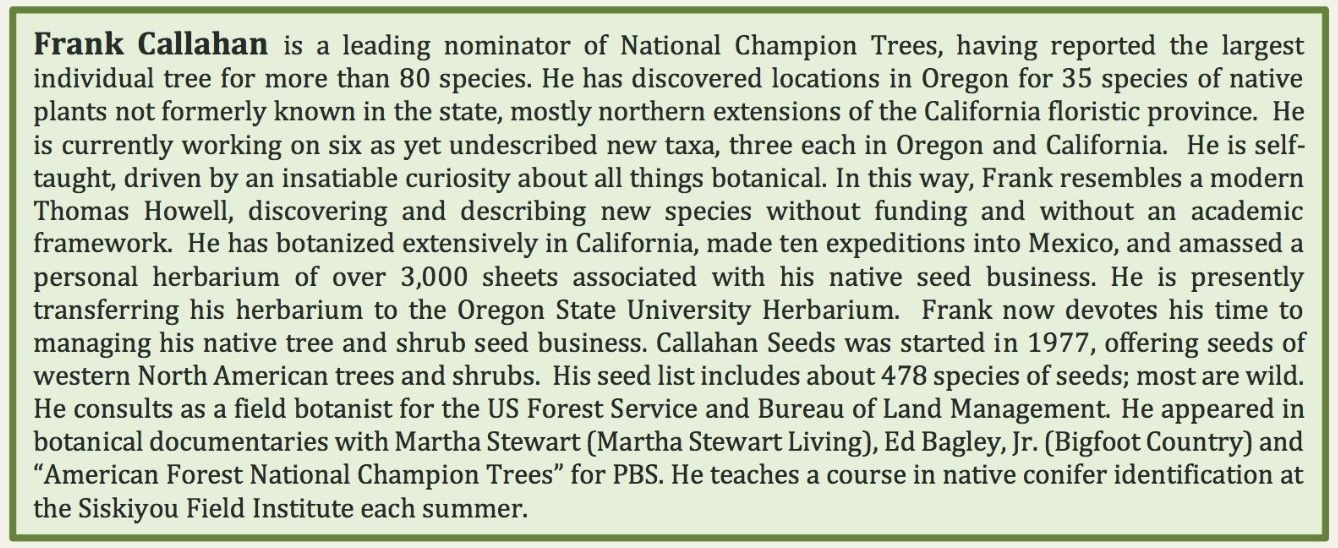 |
Oregon ex-situ locale Florida Torreya
|
FRANK CALLAHAN received the Fellows Award of the Native Plant Society of Oregon:
Kalmiopsis, Vol 16, 2009 • Callahan award • Species list of "first recorded" in Oregon by Callahan
• October 2021 FRANK CALLAHAN reports effects of summer temperature stress
October 14, 2021. "I checked on the two Torreys at my mother's place and must report they are not doing well. We had 2 days of 115 degree temps. and many days over 100 d.f. and the trees looked quite scorched from the heat and a very poor seed crop. I will check on them again when the seeds drop and get back to you." Editor's note: Because genus Torreya is a subcanopy group, plantings in and maintained as full-sun sites are vulnerable to hot, dry conditions. However, full-sun plantings are where seed production is dependably great.
• October 2019 Collecting vertically oriented tips of lateral branches
October 3, 2019, CONNIE BARLOW visited the 2 sets of Florida Torreyas planted some 30 years ago by FRANK CALLAHAN. Her main goal was to collect some of the vertically oriented branchlet tips and send them for rooting to and by JACK JOHNSTON in northeast Georgia and CLINT BANCROFT in southeast Tennessee.
As to BASALS, Connie was at first surprised that there were no really good-looking basal sprouts at the base of either of the two trees. But then she realized that because both were planted in full sun, the low shrubby branches precluded basals from contributing any sunlight-derived photosynthates, so the trees probably wouldn't bother creating good basals unless they felt stressed and possibly facing death.
PHOTOS BELOW 3 OCTOBER 2019 TORREYA "SHRUBS" IN HAWTHORNE PARK, MEDFORD:
ABOVE: The 2 shrubby torreyas are now exposed to full sun. They fully recovered from the "bronzing" they had experienced 3 years earlier when a tall conifer that had been shading them on the south-facing side (to the right in the above photos) was cut down after dying (in the heat and drought). To see the bronzing, access the February 2017 video below. Note: It will be important to learn whether the green mowed lawn visible here signifies that this parking median receives supplemental watering, as do plantings elsewhere in this park.
ABOVE: Each of the two torreyas shows the shrubby multiple stems that specimens grown from rooted branchlets will display their entire lives.
ABOVE: Because Connie's mission was to collect cuttings that might be able to produce tree-like structures once rooted, she looked at both the basal structure and the sprawling branch tips. LEFT is the most vertically oriented set, not of basals, but of sprouts arising from the lowest horizontal branch of the only specimen that had the best almost-basals. RIGHT: Both specimens excelled in producing vertically perfect radial branch tips in abundance on their south-facing sides (and the eastern tree, also on its east-facing side).
HYPOTHESIS: Frank must have rooted female branchlets from the original trees, and since branchlets probably never switch to the opposite sex (unlike seed-grown specimens, which are capable of growing both genders of reproductive cones), any nascent cones never receive pollen. It is therefore remarkable that this torreya actually produced "seeds" as large as these.
4 OCTOBER 2019 REPORT BY CLINT BANCROFT:
June 12, 2019 FRANK CALLAHAN wrote: "Here are some images of Torreya taxifolia trees at my late mother's property in Medford. Mickey just had her 95th birthday and passed away 6 days later, and her house and property are now up for sale. (I trust we can make a deal to care for the trees with a new owner.) The two trees are doing quite well as you can see. (Connie added the white stars). That is a bluish Douglas fir in the background. The tree on the right is an arborvitae. There is no crop to report for this year.
24 minutes - filmed February 2017
"The seed source of our plants was the US National Arboretum; seeds arrived late fall of 1995 and germinated in our nursery the following year. Some of the plants were taken by the Santa Cruz Arboretum, none of which have done well. Two of the plants were planted at my mother's property in Medford, Oregon and those trees have been heavy seed producers over the last 3 years. The trees are open growing (full sunlight) and are thriving in heavy black clays."
"I usually keep the seeds moist in a sterile medium (vermiculite) for 6 months or more. Adding bottom heat can improve the maturation of the embryo and foster more rapid germination. The two trees at my mother's place have no nearby Torreyas for pollen exchange."
EDITOR'S NOTES:
2. Several Torreya Guardians gratefully accepted donations of seeds from Frank's harvest 2016. The distribution of seeds via Torreya Guardians from the pair of Medford trees totaled 3,900 that year.
3. Frank Callahan wrote by email 30 March 2017: "There are no known plantings of Torreya californica in the Medford area or the Rogue Valley, for that matter. So there is no chance of pollen transfer to the Torreya taxifolia sites." Via Paul Camire email 23 Aug 2018: I narrowed down the parentage of Frank Callahan's trees. Frank's trees likely originate from 4 specimens at the National Arboretum. Three are located in Fern Valley Native Plant Collection in roadside bed R7-one received March 14, 1984 from Tom Dodd (specimen 54065H), two received December 13, 1985 from Tom Dodd (specimens 56828H and 56828J). The last is located in bed 1 of the Gotelli Conifer Collection and was received from Maclay Gardens in 1968 (specimen 31183J).
• First Germinations of Seeds Planted from Medford Oregon 2016 harvest
26 SEPTEMBER 2019 CLINT BANCROFT WROTE: "My own Medford seeds got raided by a rodent and appeared to all be gone, but I just left the pot alone and this year a single seed the rodents missed germinated and is doing well in a cage! Jack Johnston apparently had good luck with his Medford seeds and gave me 4 and also 4 to Paul Camire. So I do have Medford in my collection but would really like to have more. [Note: Very few seeds have been produced by the two neighboring trees at Medford since their huge seed production of Fall 2016. See the March 2017 entry noting Clint's receiving 200 Medford seeds.]
31 DECEMBER 2019 ADDON: "The pot my Medford seeds were in was wire-mesh covered and should've been safe from squirrels. However something dislodged the wire mesh cover and squirrels got into the pot."
Visit Clint's Ocoee Watershed, Tennessee Torreya page to learn the full context of his Torreya plantings (near Chattanooga, TN).
"These trees are not great seed producers, but they are a bit larger than the two trees at my mother's place.
"I have found that the trees from cuttings, which these two were, do not exhibit the conical form (as the cuttings came from side branches). To obtain the tree-form, it is necessary to raise them from seed or from terminal growth points."
Frank has been instrumental in effectively doing (solo) an emergency assisted migration of the gravely endangered Chihuahua Spruce (of NW Mexico). The local paper in Medford Oregon published a news article in 2007 of Frank's role in acquiring seedlings of the spruce in Mexico and planting them 25 years ago in a Medford local park. Read this news report online: "Pair team up to save endangered trees". Frank is quoted that the Chihuahua Spruce he planted had begun producing seeds and that the trees were doing well: "It's the spruce on steroids."
Go to the Torreya californica page on The Gymnosperm Database website and do an internal search for "Callahan." There you will see Frank's involvement in documenting ages of fallen specimens of the oldest California Torreya trees, including one whose disk contained 480 rings over a diameter of 45 cm. (See entry below.)
LEFT: Photo of Frank Callahan with Partial disk #1. He wrote January 3, 2017:
"This tree was growing "near Mendocino", Ft. Bragg, California, nominated in 1945 by Edward Simons and the critical measurements are: Circumference: 14'10" @ 4.5' - 141' tall - 39' = crown spread. Total points = 329 (1945). This tree was determined to be ca. 236 years old from actual ring count, however the center was rotted out and a guesstimate of somewhere between 275-286 years is given. This is the earliest reported National Champion tree in the American Forest records. This is the tree that was illegally harvested on Boise Cascade property holdings...
"... The tree with 286 rings is from Ft. Bragg, CA. This tree was cut down by some employees of Boise Cascade, who almost lost their jobs, as Boise's police caught them in the act and took their chainsaws and cables and winches. The management of Boise saved me a sample of the tree which was the national champion before the Swanton tree was measured."
"WINCHUCK TREE" IS CALIFORNIA TORREYA in SOUTHERN OREGON: January 3, 2017 email from Frank Callahan: "Disk #3 Winchuck tree: ref: Email 12/31/16 - This is the most recent image that I sent you. Disk 480 years old taken @ 20' from base, basal ring count 512 years (rep. Jim Smith). Rumors that this tree was felled in the 60's turned out to be another tree, not a Torreya. This tree was felled in 1999 as it was dead, however Jim did not report exactly when the tree died. Sorry, I earlier confused the Willits partial disk with the Winchuck disk. This is the Oregon tree that was located north of the OR/CA border and the northernmost known for the species.
CALIFORNIA TORREYA: Autumn 2016 Frank Callahan told Torreya Guardians:
NOTE BY CONNIE BARLOW ON PHOTO BELOW: Connie Barlow visited Frank Callahan for the first time in February 2017, in order to receive donated seeds for further distribution. At that time, Frank donated to her a photo-scanned copy of the HERBARIUM PAGE (Winchuck River, Oregon). As of January 2024, the page hangs on a wall in her rented apartment in Ypsilanti, Michigan — where she and her late husband, Michael Dowd, retired in 2020.
TEXT OF ABOVE PHOTO RIGHT CORNER (by collector 1949 Dee Hendrickson):
HOW TO FIND THE ORIGINAL HERBARIUM SHEET ONLINE (above photo) can be found as directed below. Frank Callahan sent Connie Barlow these directions 21 January 2024:
• Partial disk #2. This is the Willits tree: 119 years old, exact diameter unknown, height measured at 157' (calculated from felled tree). This is the tallest Torreya californica that I know of and possibly the fastest growing.
• Disk #3 Winchuck tree: ref: Email 12/31/16 - This is the most recent image that I sent you. Disk 480 years old taken @ 20' from base, basal ring count 512 years (rep. Jim Smith). Rumors that this tree was felled in the 60's turned out to be another tree, not a Torreya. This tree was felled in 1999 as it was dead, however Jim did not report exactly when the tree died. This is the Oregon tree that was located north of the OR/CA border and the northernmost known for the species.
• No disk yet: This is the Swanton tree: Email from Steve Auten and National Champion nomination by Frank Callahan (1992). The critical measurements are: just under 21' in circumference @ 4.5' - 96' tall - crown spread = 68' - Total points = 364. Steve Auten reports the age from this single trunk tree to be 230-250 years old, however the center 12" is rotten.
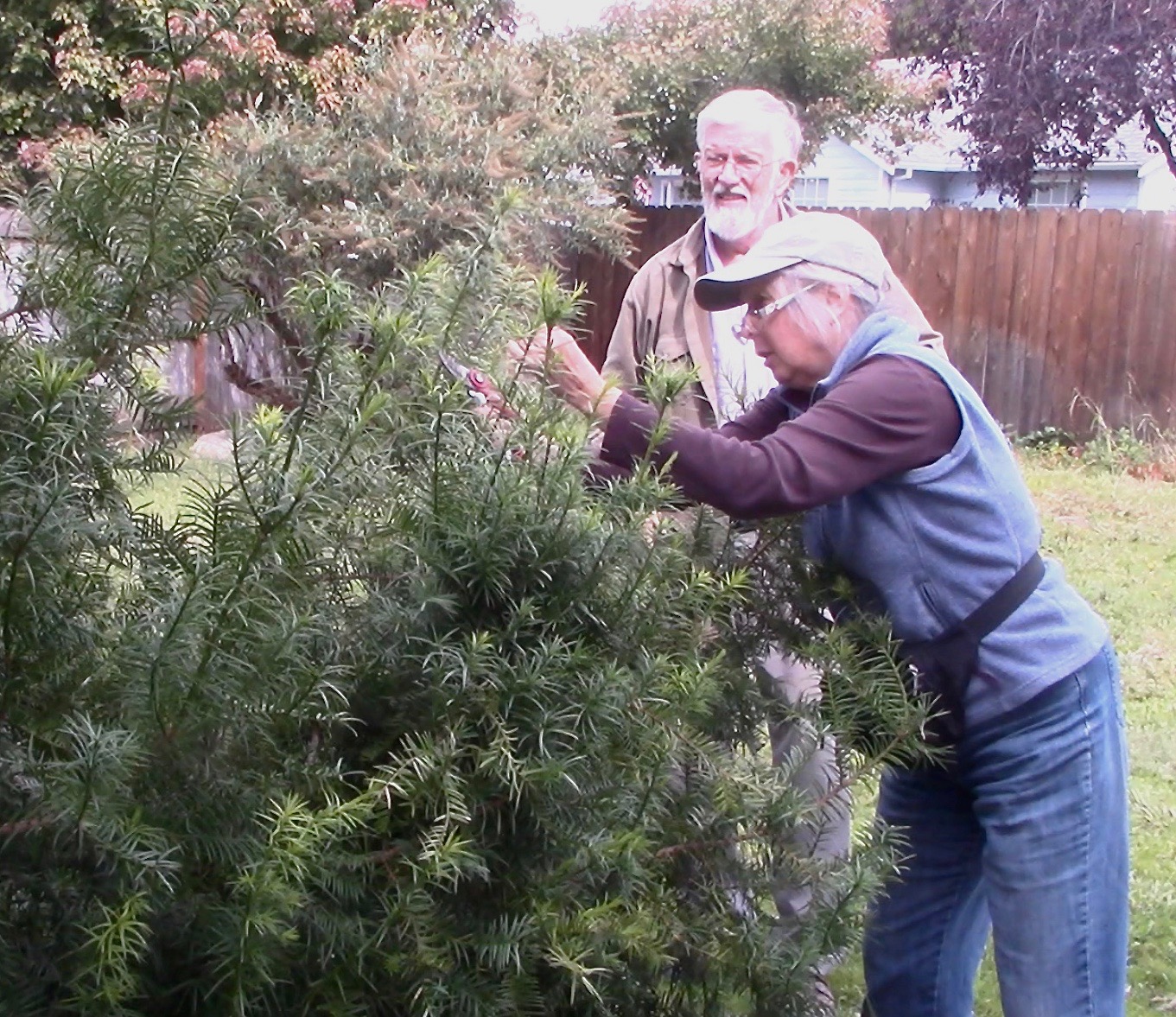
October 3, 2019, CONNIE BARLOW clips the most vertically oriented branch tips she can find on the two seed-grown trees FRANK CALLAHAN (standing behind) had planted at his mother's home in Medford:
3050 Jenero Court, Medford
Connie notes that the most vertically oriented branchlet tips she could find were not quite as leader-like in structure as the ones she had clipped from the shrubby, rooted-branchlet "trees" at Hawthorne Park earlier that day.
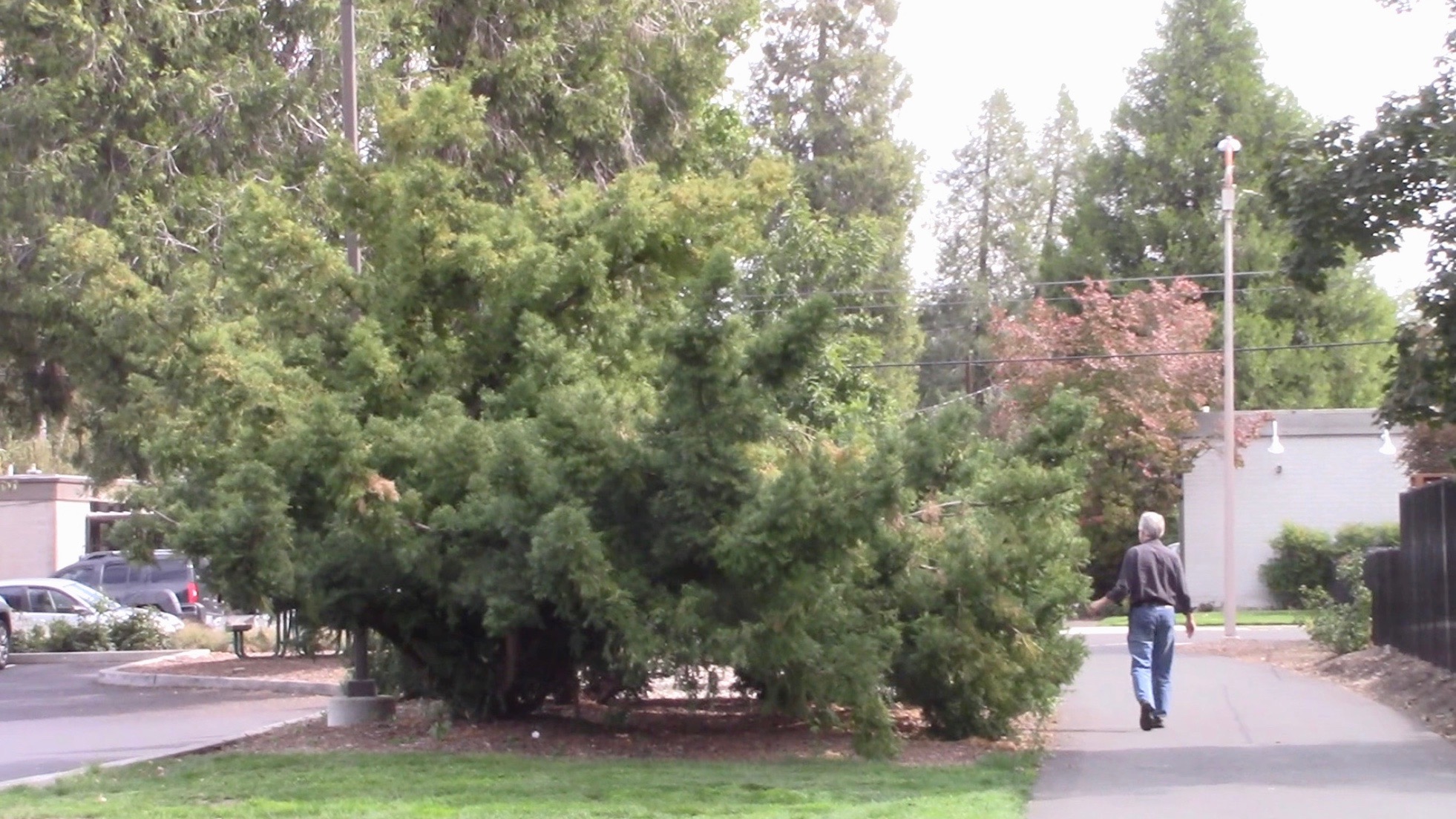
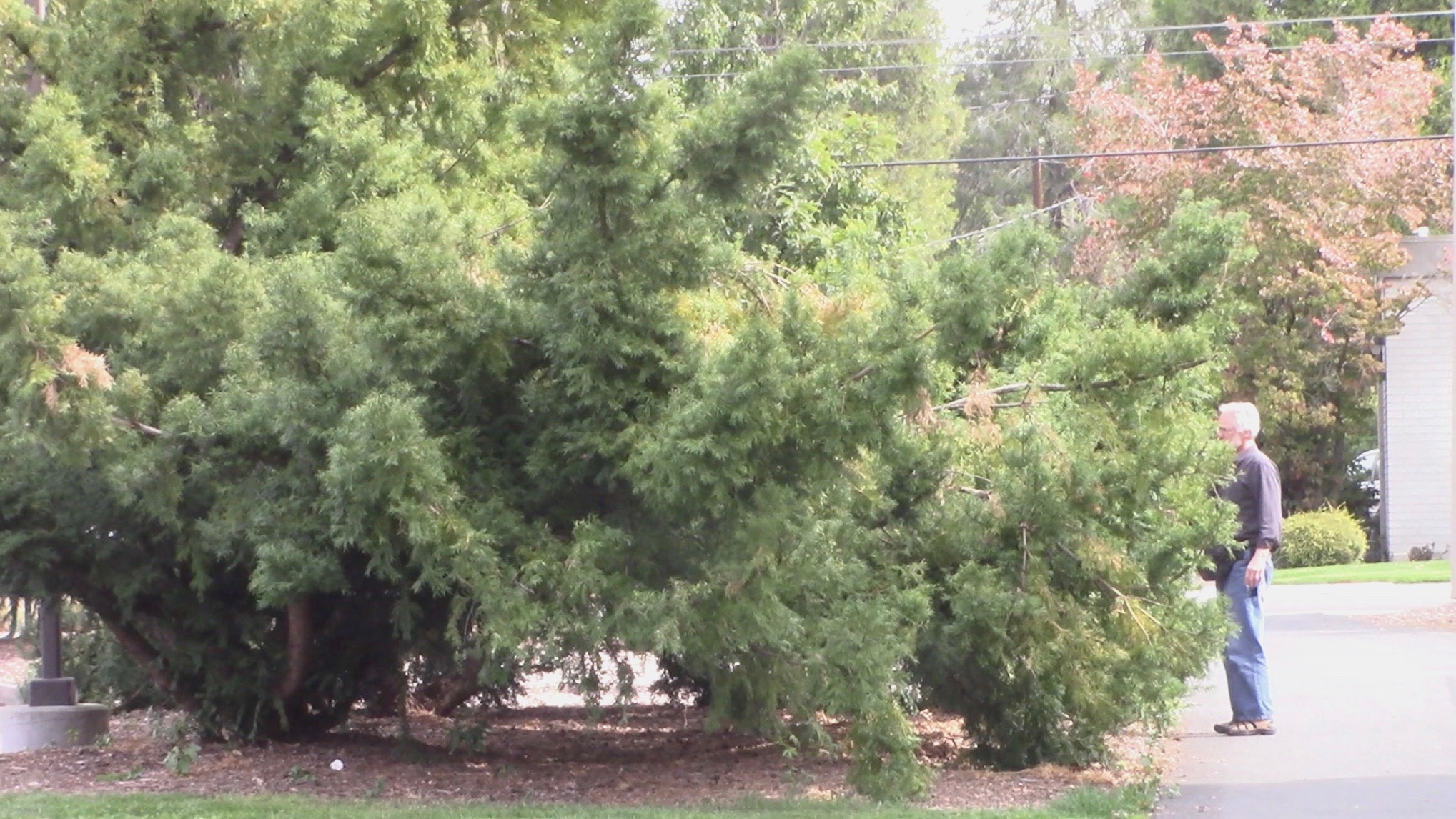
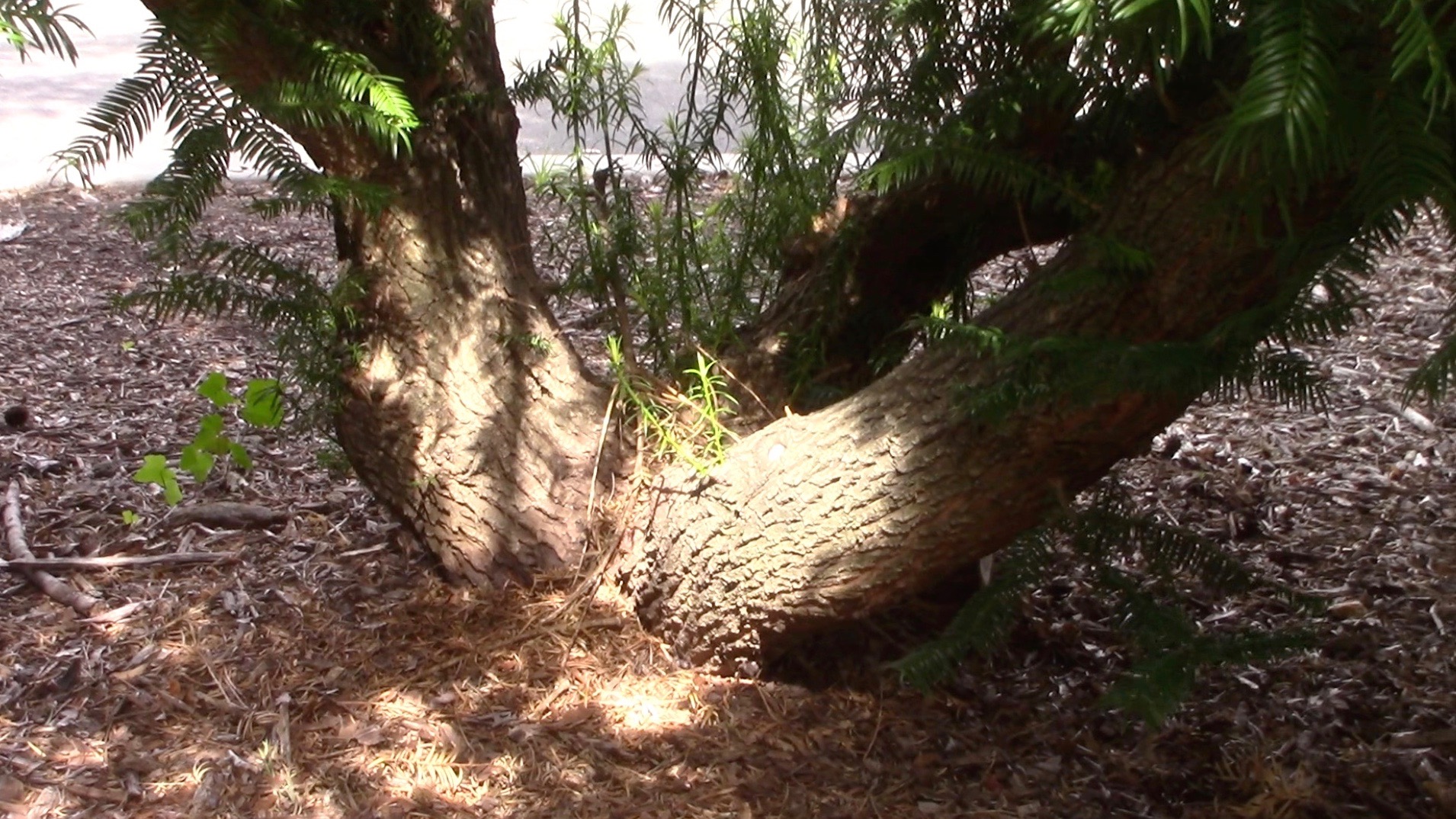
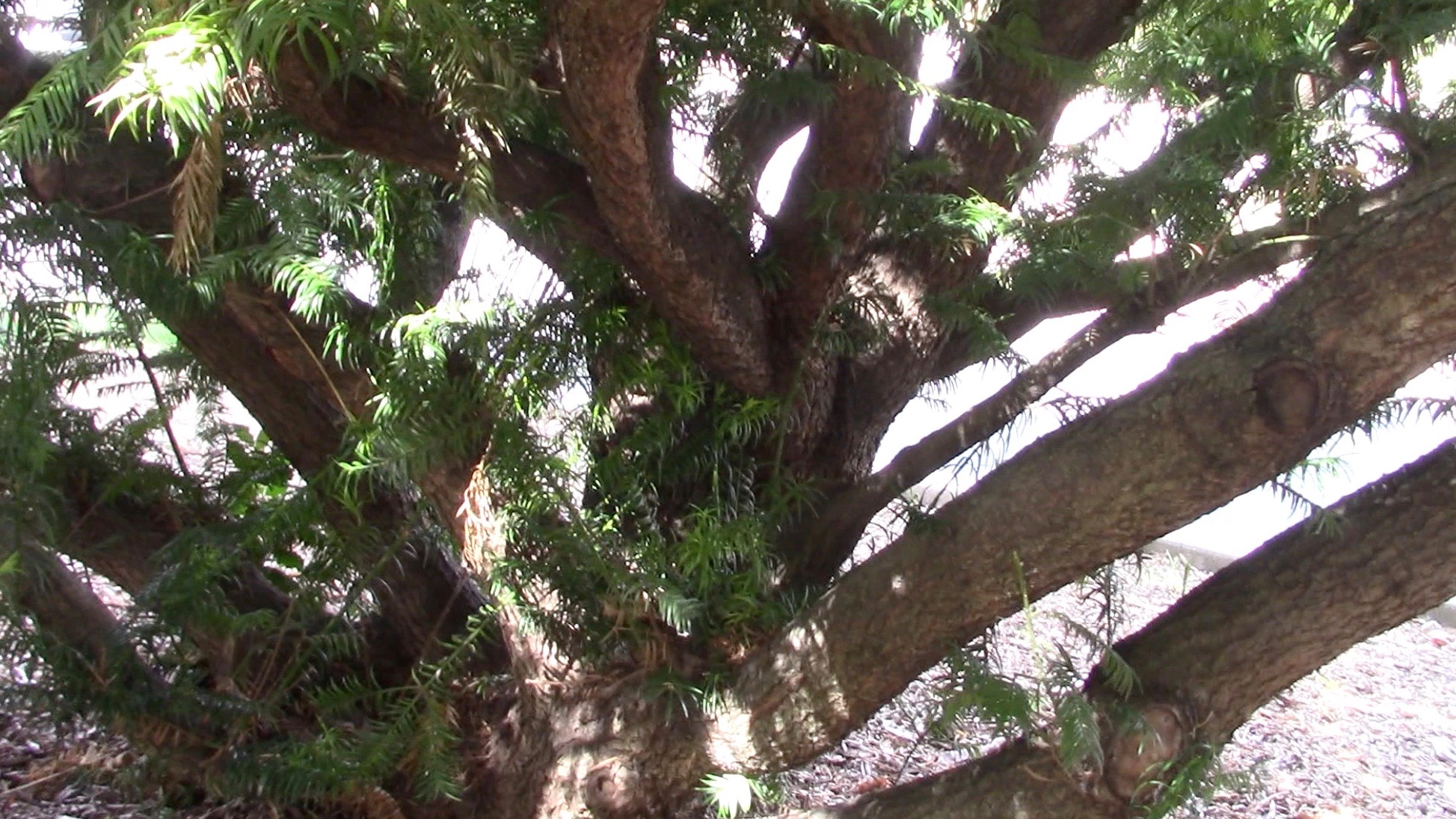
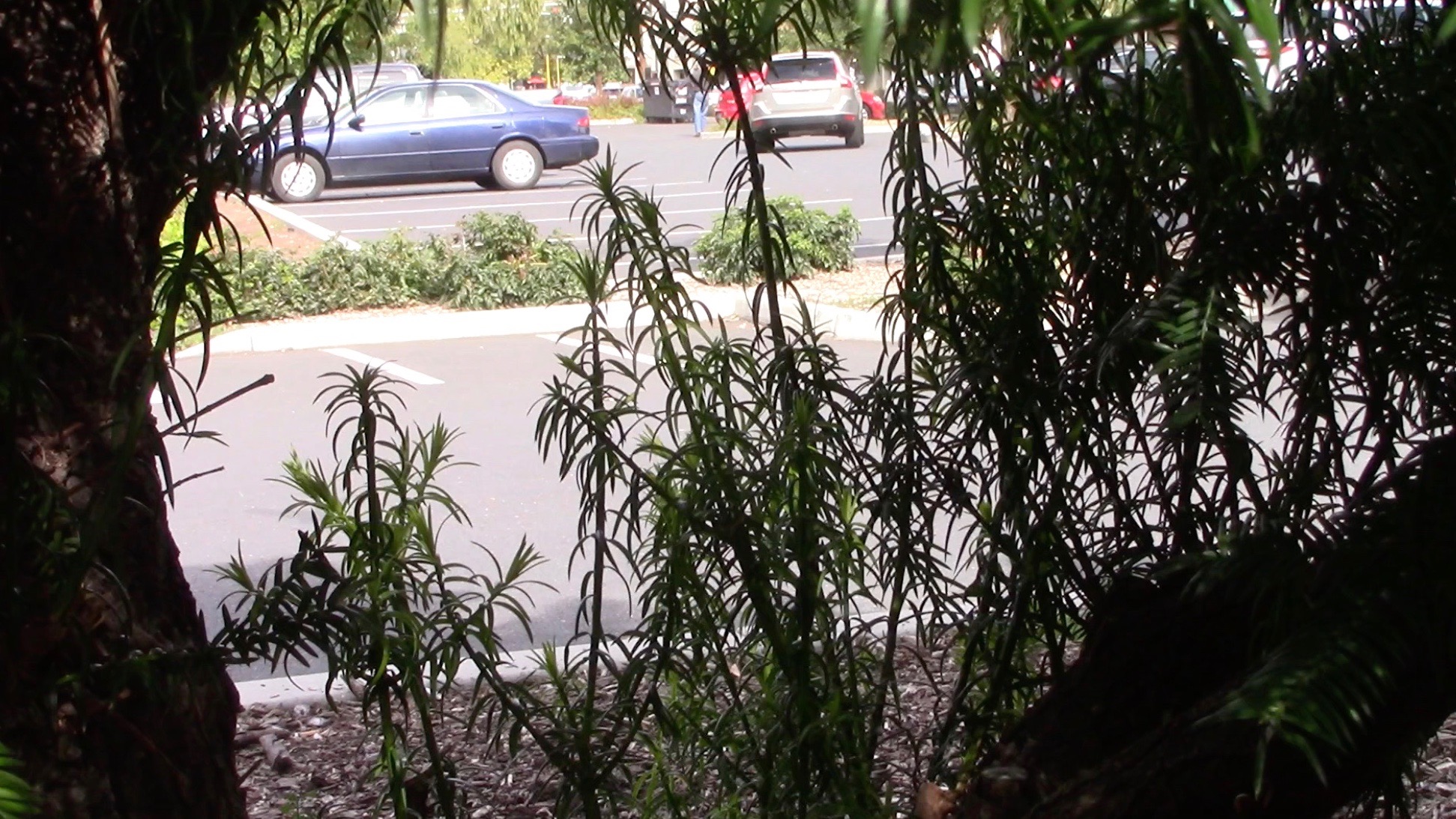
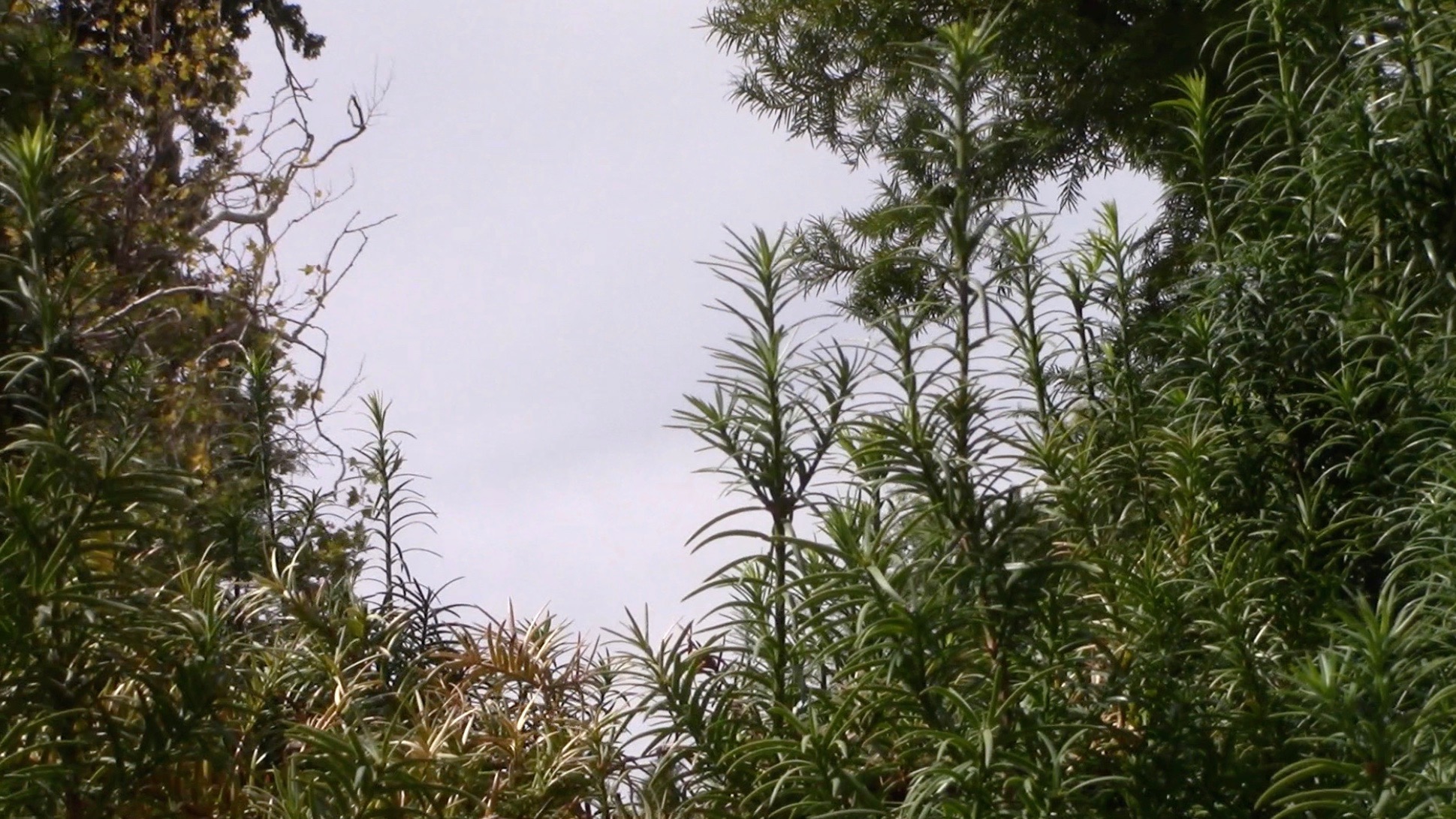
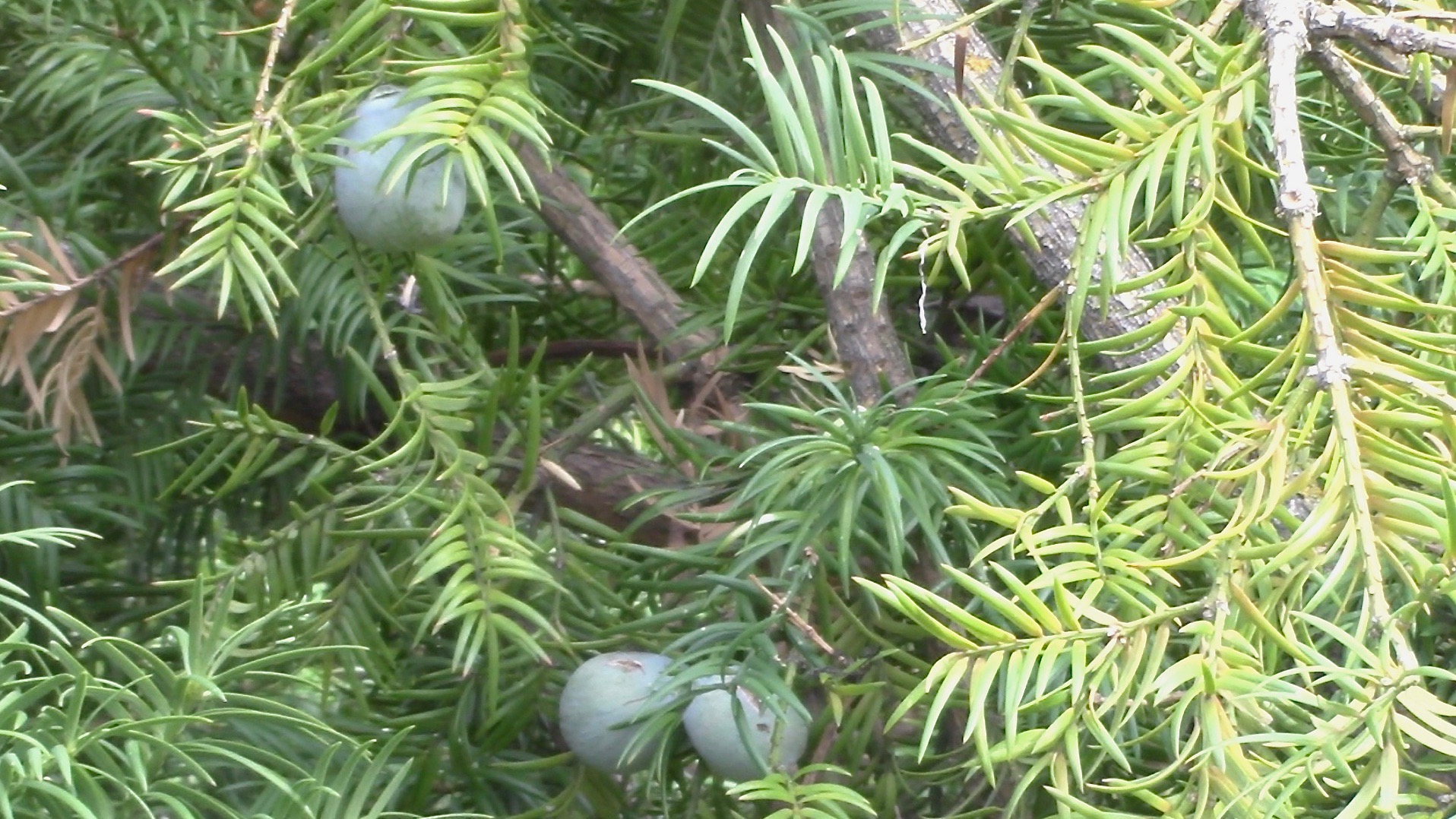
October 3, 2019, Connie was surprised to see 3 full-size seeds on the south-facing side of one of the shrubby torreyas. Because her previous visit (February 2017, see video below) had Frank showing several fallen, very small and nonviable "seeds", Connie decided to harvest these to test whether these also were nonviable. She kept them outdoors in her van until October 29 (parked in the cool Seattle area), and then she cut them open; PHOTOS BELOW. Clearly, these seeds too were nonviable.
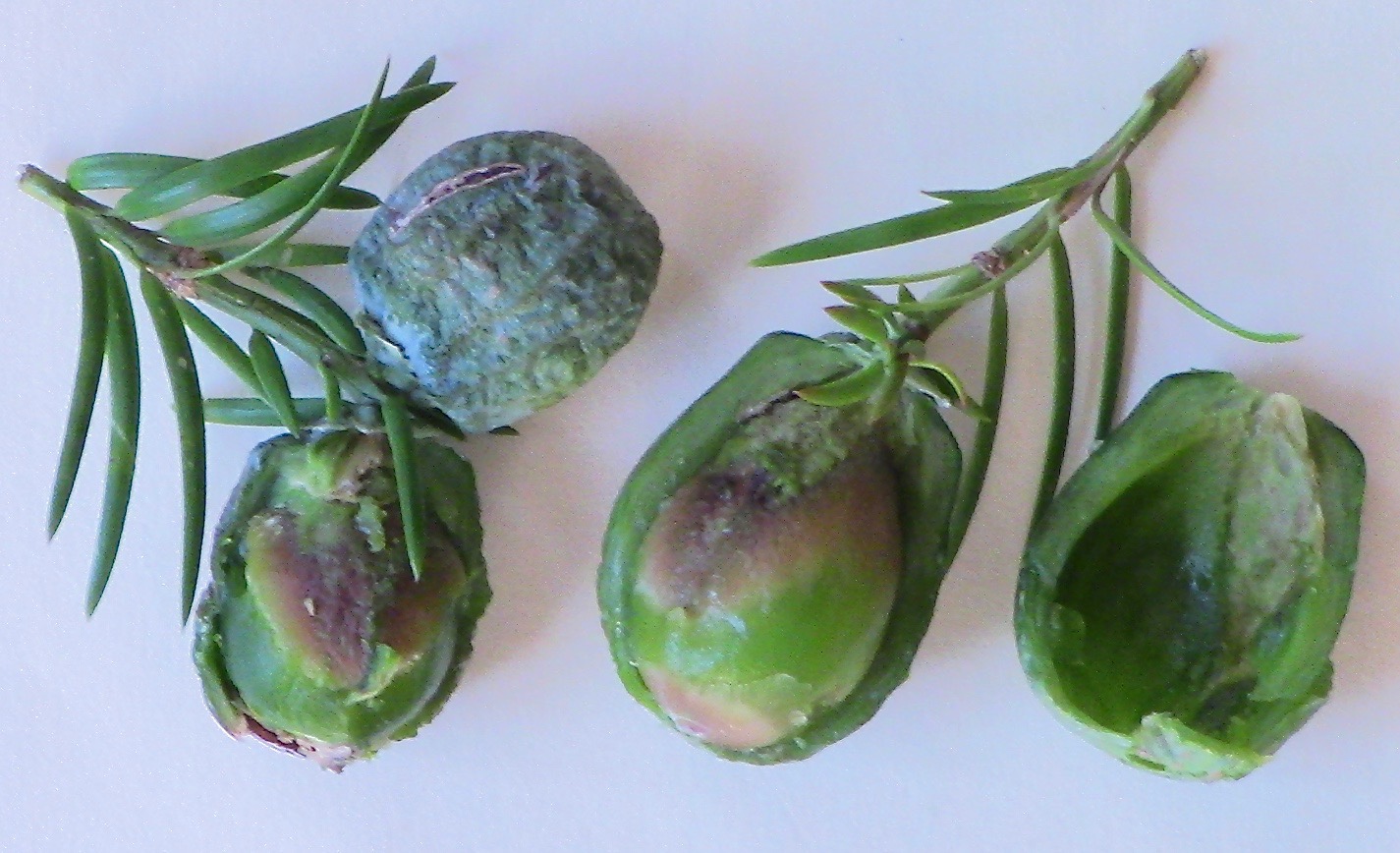
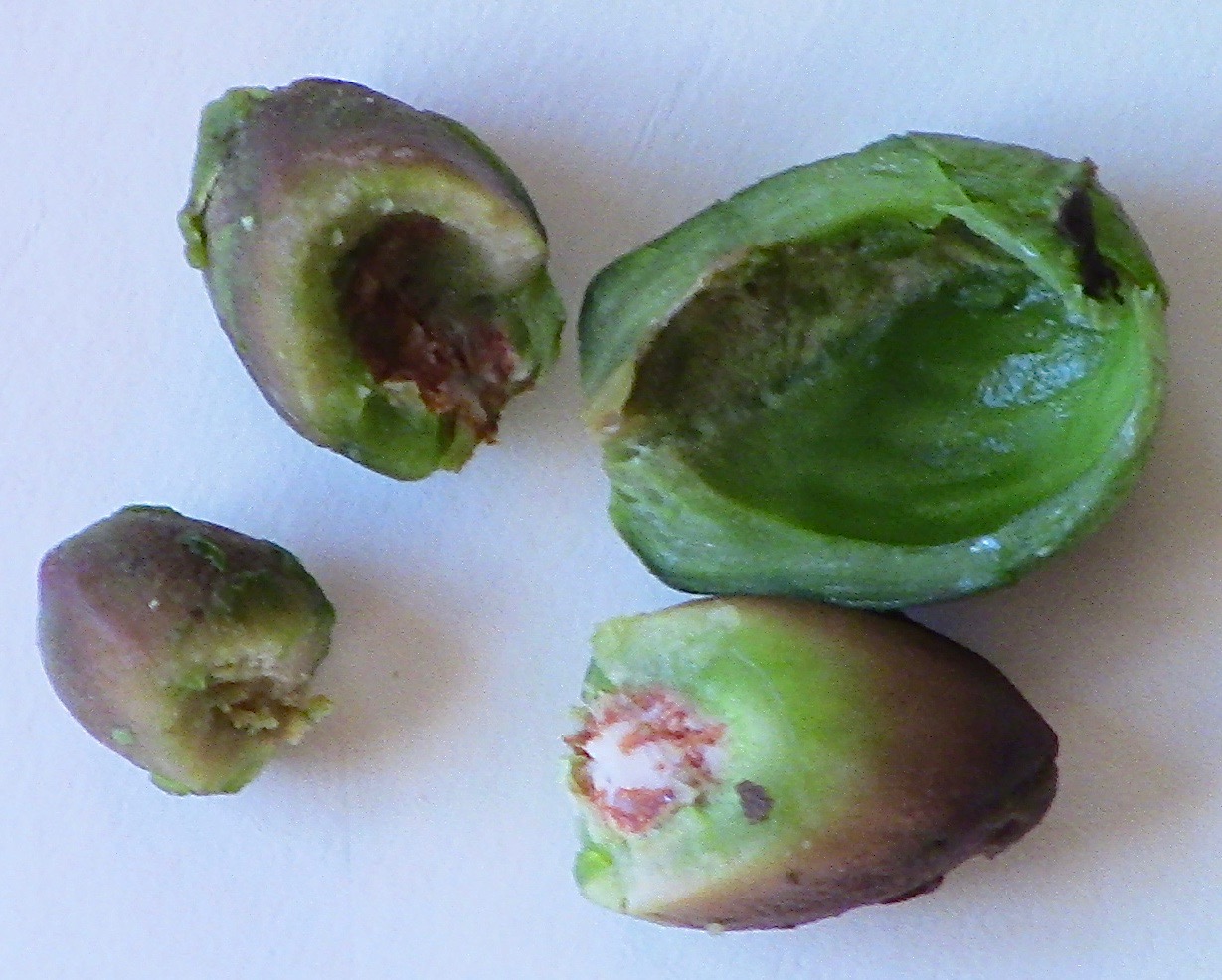
"Medford cuttings arrived safely today Friday October 4th. They are placed into vertical orientation prior to ticking. The identifying tags got very wet and soggy so I'm not going to be able for sure to know what is what. Several cuttings had fairly significant tip wilting. Unless they were wilted before they were cut they got hot somewhere along their route. They did not sit in my mailbox since I waited at the road for the mail carrier to arrive and took the package immediately to the house and opened it. I retrimmed the bases and put them in glasses of water covered by a plastic bag and put them in the refrigerator. I will see what, if anything, that accomplishes. I assume it was cooler in Oregon than it is here. Cold seems to help stressed cuttings.
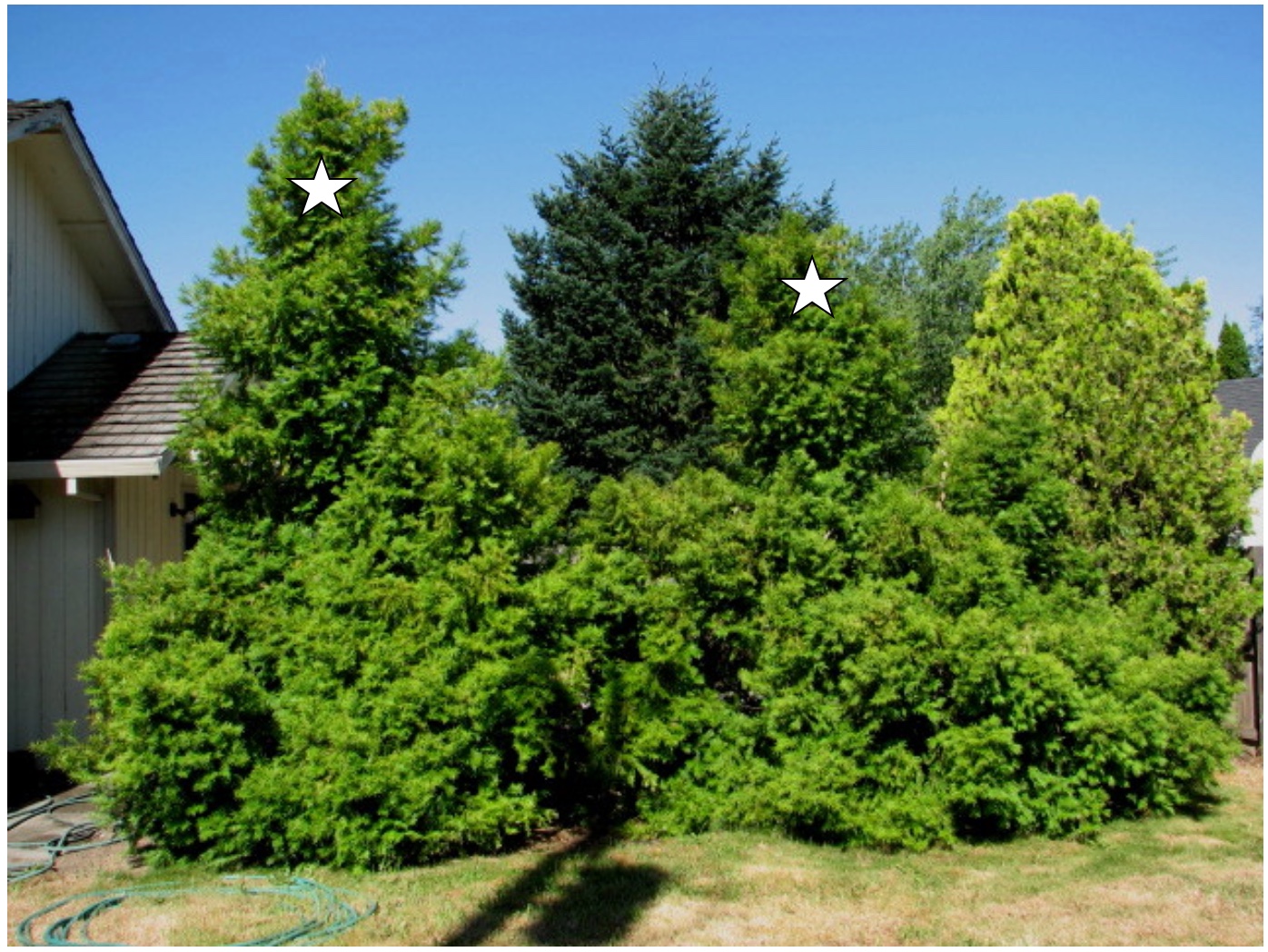
May 31, 2019 FRANK CALLAHAN wrote: "I was just over to my mother's place for her 95th birthday. The Torreyas are doing well; however there has been little seed production since your visit. Speaking of seeds, how was the germination rates on all the seeds that were sent out?" [from the Fall 2016 harvest of seeds from the two Florida Torreya trees, shown at left with white stars]
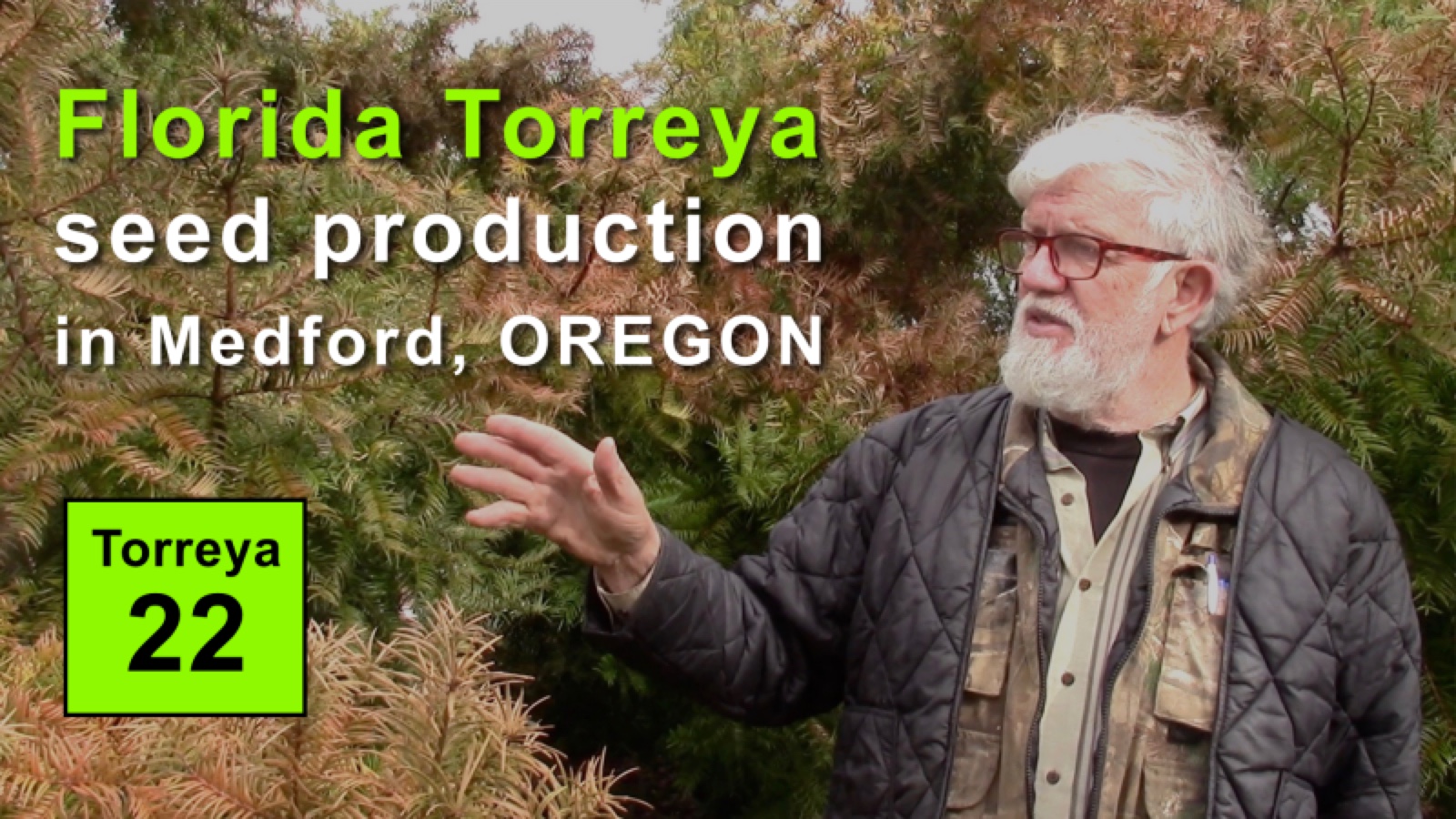
Florida Torreya Seed Production in Medford, Oregon (2017) is drawn from video footage captured by Connie Barlow on February 3, 2017. Frank Callahan transferred 1,000 seeds from the 2016 autumn harvest of Torreya taxifolia seeds — from two trees he had germinated from seed at an ex-situ planting (Medford, Oregon) some 22+ years earlier. He also shows two shrubby-form trees of Florida Torreya, about 22 years old.
Significant discoveries: (a) rooted branchlets will not develop into single-stem trees and (b) Florida Torreya is harmed by sudden exposure to full-intensity sunlight, and even new leaves produced in direct sunlight may never adapt to sun-scald.
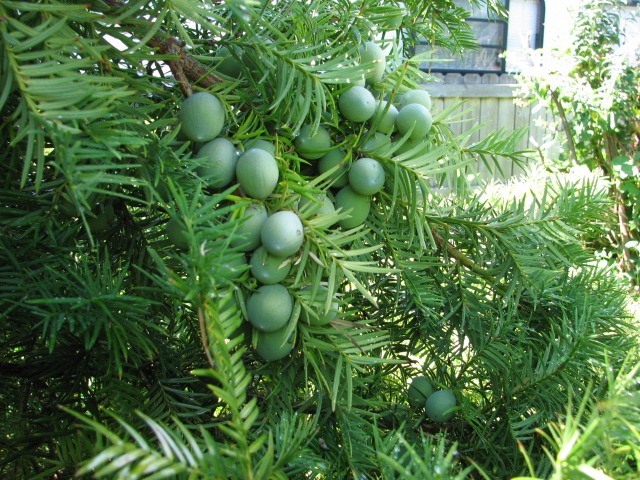
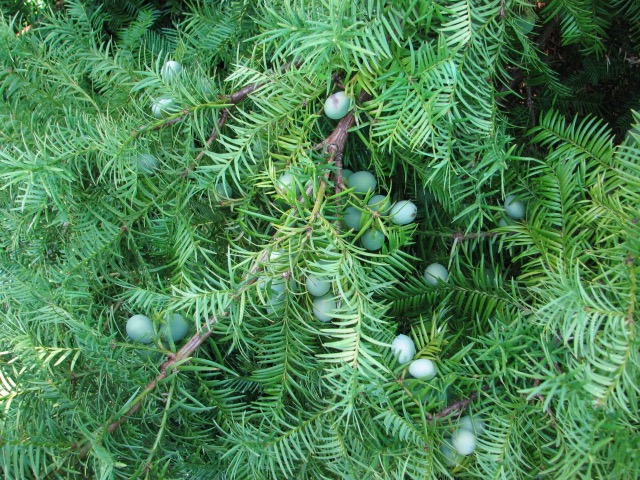
PHOTOS LEFT: Autumn 2016 seed production on the two "trees" (both initiated as rooted branchlets, so they exhibit shrubby growth) at the home of Frank Callahan's mother. Frank reported that past years' seed crops have been exceptionally viable, so this year's probably is too. He wrote:
"We have germinated seeds from the trees at my mother's place (100%). The seeds take some time to germinate, due to the fact that at fruit-ripening time the embryo is not mature and may take some months of warm stratification and cool-moist stratification before germination can occur.
In an email to Lee Barnes on 9/29/16 Frank wrote: "We are in the Sunset Garden Book as Zone 7, the trees have survived -6 degrees F. in Medford w/o damage. Both of these trees exhibit male and female 'flowers', which is unusual for this taxon."
1. A number of Torreya Guardians report similar male/female results during our decade+ of acquiring seeds of Torreya taxifolia from reproductive individuals in the eastern USA.


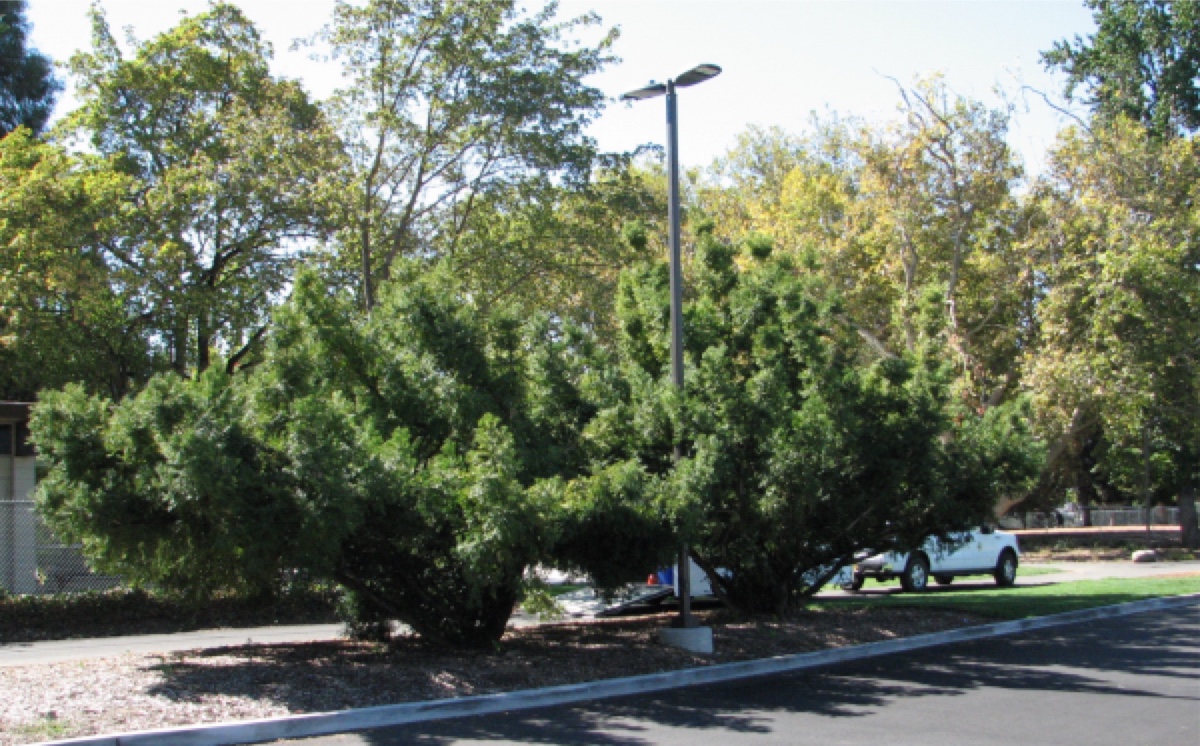
PHOTOS ABOVE AND LEFT: "Two (now multi-stemmed trees) I planted some 20 years ago at Hawthorn Park, Medford OR.
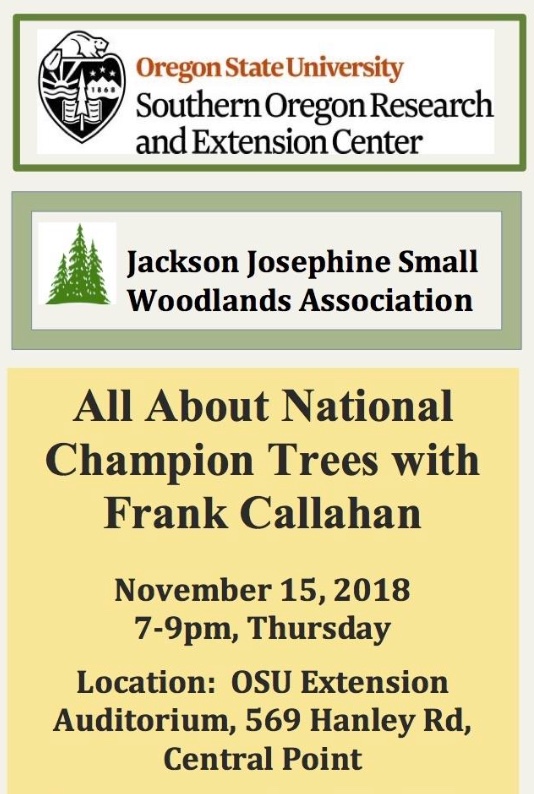
Frank Callahan, a conifer aficionado who specializes in the genera Pinus and Cupressus, has nominated more than 80 National Champion Trees certified by American Forest in Washington, D.C. He has published in Herbertia and Phytologia (Calochortus syntrophus/C. coxii) and revised the entire genus Calochortus in Bulbs of North America. Frank owns and operates Callahan Seeds. See a full biography of Callahan in a 2009 issue of the journal of the Native Plant Society of Oregon. Access a short biography of Frank on page 15 of a 2013 issue of the same journal, at the end of his coauthored historical report, "Botanizers in the Land of Conifers.
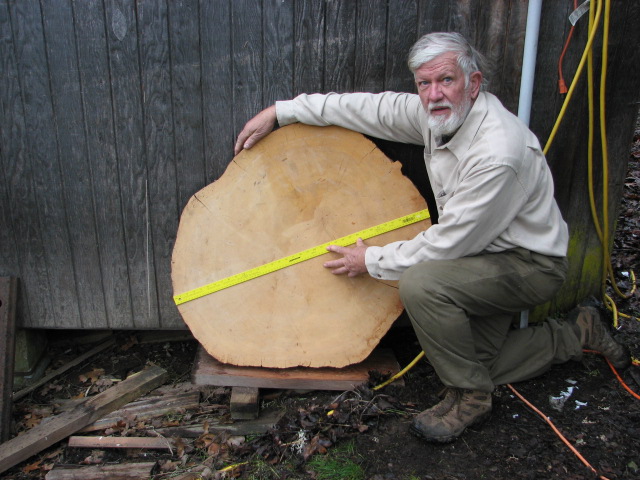
"We also have a lot of 1st-year potted Torreya californica at Plant Oregon Nursery. in Talent, Oregon. The seed source is Swanton, California near the train station. Lots of large trees there."
Note: Torreya Guardian Connie Barlow visited the Swanton CA trees in 2005 and posted a photo-essay of the giant California Trees in the Swanton (Scott's Creek) watershed north of Santa Cruz. Connie comments: "I am thrilled to hear that Frank is involved in ensuring that a nursery in Oregon sells California Torreya — as it has a highly fragmented range in California and would benefit from some "assisted migration" into suitable habitats in Oregon."
(text contributed by Frank Callahan)
Lower Winchuck River, north of Peavine Ridge on flats. Large tree over 6.6' diameter and 70-80' tall — tree divides into 3 trunks about 10' above ground. Ground littered with spent seeds and prickly leaves. Some of the flats were recently logged for conversion to pasture. This tree was spared as it is too limby, hence no lumber value. Private property. p. 191-193 Sudworth (1908) does not list in Oregon.
FRANK CALLAHAN (3 January 2017) to Barlow: Here is the data on the disks or partial disks that I have on Torreya californica.
Regarding Torreya californica in Oregon, go to: Consortium of Pacific Northwest Herbaria - then to: cpnwh database search - in the scientific name box for genus - type in torreya then hit the search button then scroll down to # 16 and tap onto the image which should be a voucher by Dee Hendrickson the plant was known as Tumion at the time which now is Torreya. His collection is from 1949 and he used the Sudworth manual for ID and also note the list of conifers in the area. You might want to copy this voucher and put it on your website for inquiring minds or give a link to the specimen. Direct link to page.
• Partial disk #1. This tree was growing "near Mendocino", Ft. Bragg, California, nominated in 1945 by Edward Simons and the critical measurements are: Circumference: 14'10" @ 4.5' - 141' tall - 39' = crown spread Total points = 329 (1945). This tree was determined to be ca. 236 years old from actual ring count however the center was rotted out and a guesstimate of somewhere between 275-286 years is given. This is the earliest reported National Champion tree in the American Forest records. This is the tree that was illegally harvested on Boise Cascade property holdings.
Frank Callahan wrote in September 2016:
"Torreya taxifolia does well in SW Oregon, producing heavy crops (this year is the best) and dense growth. It, however, is not as vigorous as Torrerya californica. Two large trees of Torrerya nucifera (Asian species) are on the State Capitol Grounds in Sacramento (very orderly arrangement of the leaves."
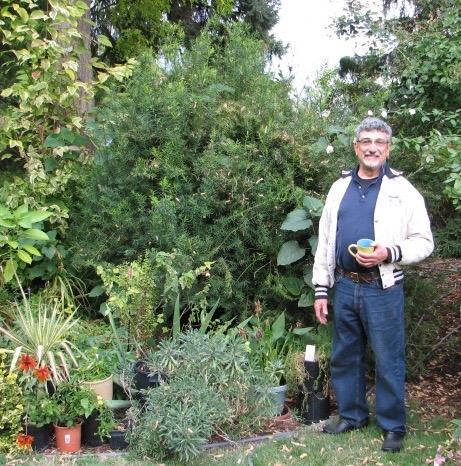 |
PHOTO LEFT: Italio Gardens in Medford, Oregon (541-840-0929). Baldy is the owner, and to his right (center of photo) is a lush Torreya nucifera. Both Torreya taxifolia and T. nucifera are growing on the premises along with many other very rare conifers. (This is the former home of Siskiyou Rare Plant Nursery.) EDITOR'S NOTE: Torreya Guardians aim to plant and "rewild" Florida Torreya into forested landscapes in the eastern USA. We are grateful for ex-situ locales for safeguarding the species (and generating seed) beyond our own region. We recognize that California Torreya may benefit from "assisted migration" northward, too — into the states of Oregon and Washington. 2022 UPDATE: Citizen-led ASSISTED MIGRATION of CALIFORNIA TORREYA began in November 2022. See our California webpage. |
• FRANK CALLAHAN has long been networking with those on the west coast recording champion trees.
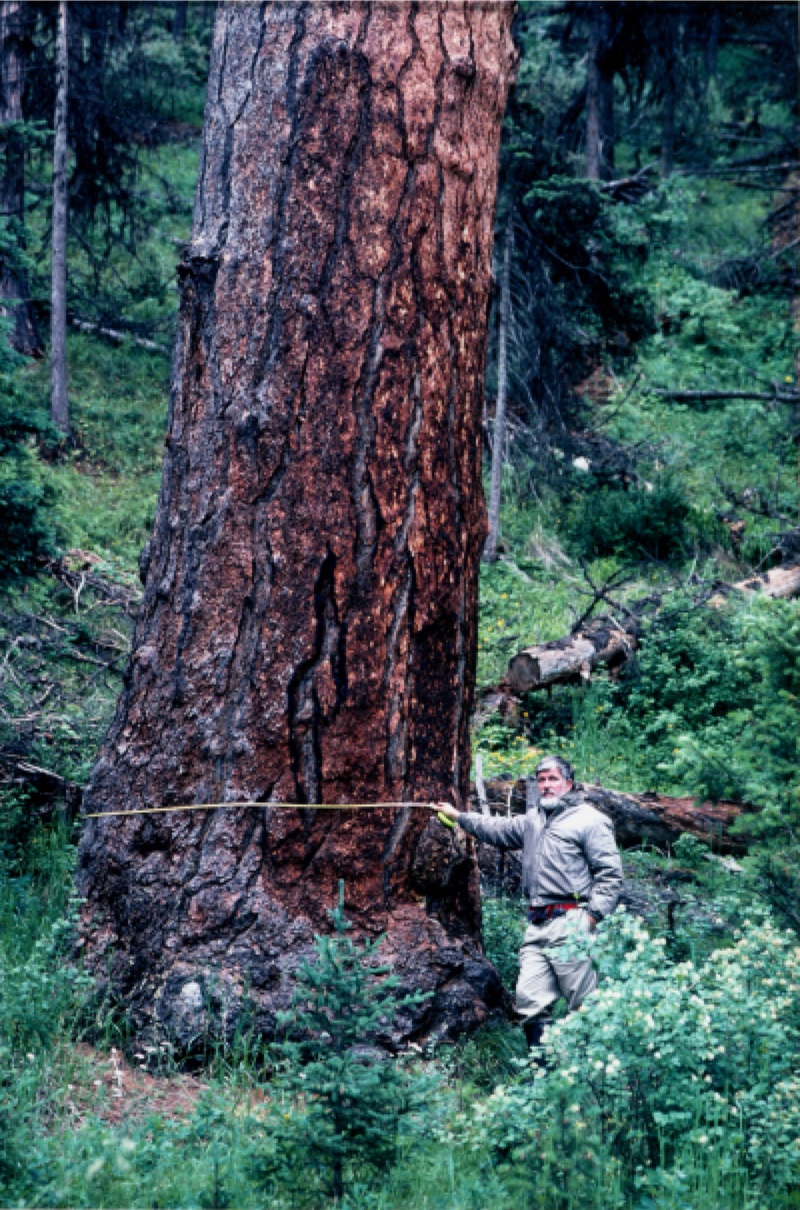 |
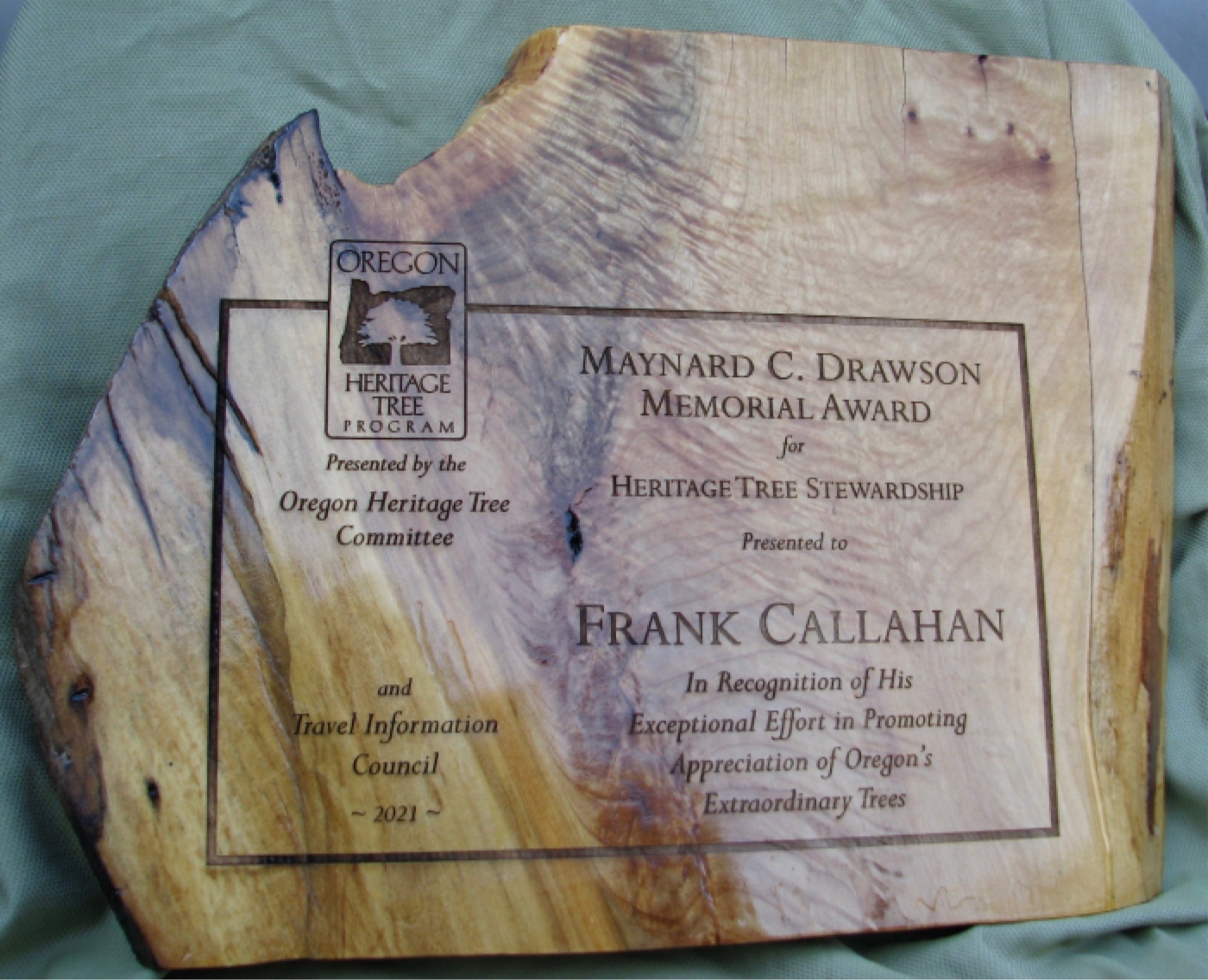
|
ABOVE LEFT: Frank Callahan sent this old photo to Connie Barlow and others in 2019, with this caption:
The Burnt Corral Larch [Larix occidentalis] which grows along Burnt Corral Creek near the Starkey Experimental Forest in Union County. This is one of those 1,000 year old trees and according to my Uncle Jake's measurements was 230' tall before the top was blown off. The tree is over 7' in diameter. This is an image taken by John Erwin of myself and this monster tree. Fortunately, the tree is on private land and protected from Forest Service harvest. Before the top was blown off, this tree was the tallest Western Larch ever recorded and the largest. Robert Van Pelt visited the tree in 2001 and to my knowledge it is still standing. I have nominated over 80 National Champion Trees over the years, with American Forests in Washington, D.C.ABOVE RIGHT: In 2021 Frank received this award.


ABOVE: Left photo is FRANK CALLAHAN with national champion Incense Cedar in Klamath Mountains, 2009. Right is the same tree after the Slater Fire in 2020. Frank writes in 2022: "This tree had an estimated age of 800 years and was hollow (read chimney) and was showered with embers in 60 mph winds and burned from the inside out. It might be noted that the tree had been long protected by its wet meadow location, however the hollow truck proved to be its weak point. Note that none of the other trees in the background burned. The stump is located between Tanner Lakes in southern Josephine County."
